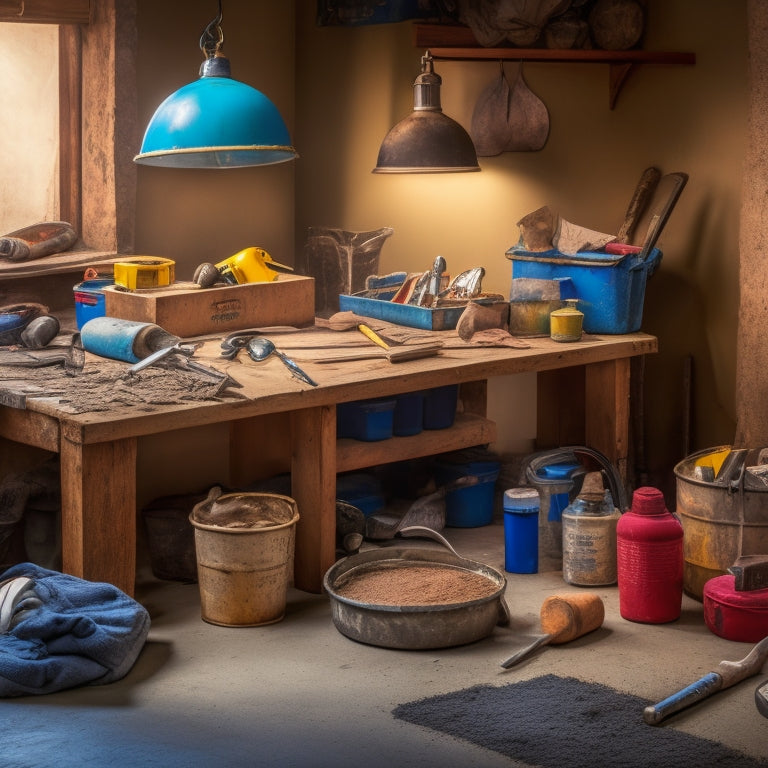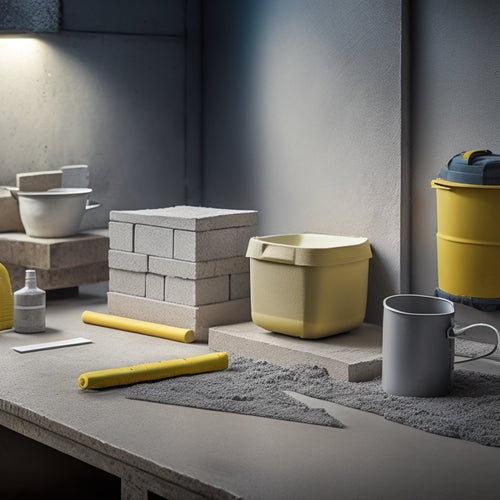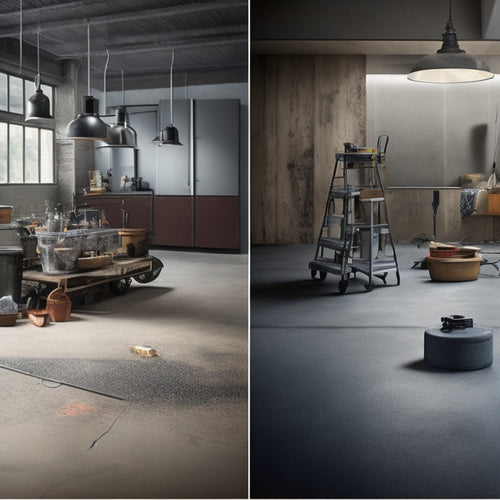
5 Key Tools for Concrete Home Repair
Share
When tackling concrete home repairs, you'll need a range of specialized tools and materials. Start with demolition and removal tools like jackhammers, chisels, and heavy-duty trash bags to break up and clear concrete. Next, prepare the surface with effective cleaning techniques, and guarantee a stable surface creation. Adhesive and bonding agents like epoxy adhesives and acrylic bonding agents come into play for strong bonds, followed by concrete patching and filling with specialized tools like trowels and floats. Finally, use finishing and smoothing tools to achieve a high-gloss finish. Now that you have a sense of the key tools involved, you're ready to explore the specifics of each category.
Key Takeaways
• A jackhammer is essential for breaking up concrete, with electric, pneumatic, and hydraulic options available.
• Chisels and points are necessary for detailed demolition work and breaking concrete into manageable pieces.
• Heavy-duty trash bags are required for collecting debris during the demolition process.
• Trowels, including finishing, pool, and edging trowels, are vital for achieving smooth, even surfaces.
• Epoxy adhesives are high-strength options ideal for structural repairs, providing exceptional bonding between old and new concrete.
Demolition and Removal Tools
When tackling concrete home repair, you'll first need to demolish and remove damaged or deteriorated sections. For this, you'll require a set of specialized demolition and removal tools. A jackhammer is a must-have for breaking up concrete, and mastering jackhammer techniques is essential for efficient demolition.
You'll need to evaluate the type of jackhammer suitable for your project, whether it's an electric, pneumatic, or hydraulic model. Additionally, you'll require accessories like chisels, points, and spades to tackle different types of concrete.
Proper debris disposal is also important during demolition. You'll need heavy-duty trash bags, a dumpster, or a debris removal service to handle the waste. It's crucial to separate recyclable materials from non-recyclable debris to minimize waste and reduce environmental impact.
Make sure to follow local regulations and guidelines for debris disposal. By having the right tools and a solid plan for debris disposal, you'll be able to efficiently demolish and remove damaged concrete, paving the way for a successful repair project.
Surface Preparation Essentials
With the damaged concrete removed, you're left with a surface that requires thorough preparation to guarantee a strong bond between the old and new concrete. This is where surface preparation essentials come into play. The primary objective is to create a clean, stable, and roughened surface that will facilitate ideal adhesion.
You'll need to employ effective cleaning techniques to remove dirt, oil, and other contaminants that may interfere with the bonding process. This can be achieved using high-pressure washes, wire brushes, or chemical cleaners, depending on the type and severity of the contamination.
A thorough surface inspection is also essential to identify any cracks, fissures, or other defects that may require additional attention.
Adhesive and Bonding Agents
How do you guarantee a strong, durable bond between the old and new concrete, especially in areas where the surface preparation process may not have reached ideal levels of cleanliness and roughness?
The answer lies in the use of adhesive and bonding agents. These specialized products provide a robust connection between the existing concrete and the new material, even in less-than-ideal conditions.
Here are four essential adhesive and bonding agents you should have in your toolkit:
-
Epoxy adhesives: These high-strength adhesives provide exceptional bonding capabilities, making them ideal for structural repairs.
-
Acrylic bonding agents: These water-based agents are perfect for bonding new concrete to old, and they're easy to apply.
-
Polyurethane-based adhesives: These flexible adhesives are great for areas subject to movement or vibration.
- Silane-modified polyether (SMP) adhesives: These advanced adhesives offer superior bonding capabilities and are resistant to water and chemicals.
Concrete Patching and Filling
Filling voids and patching cracks in concrete structures requires a solid understanding of the materials and techniques involved, as well as the right tools for the job.
As you prepare to tackle a concrete repair project, it's crucial to assess the cracks and determine the best approach. Conduct a thorough crack assessment to identify the source of the damage and decide on the most suitable patching technique. You may need to clean and prepare the area, remove loose debris, and apply a bonding agent to guarantee a strong bond between the old and new concrete.
When it comes to patching, you'll need to choose the right materials and tools for the task. Epoxy-based patching compounds, for instance, are ideal for filling small cracks and voids, while polymer-modified cementitious materials are better suited for larger repairs.
You may also need to use specialized tools, such as trowels, scrapers, and edgers, to guarantee a smooth and even finish. By selecting the right tools and techniques, you can achieve a durable and long-lasting repair that will withstand the test of time.
Finishing and Smoothing Tools
You'll need a range of specialized finishing and smoothing tools to achieve a professional-looking finish on your concrete repair. These tools will help you achieve the desired surface textures and trowel techniques that will make your repair blend seamlessly with the surrounding concrete.
Here are the essential finishing and smoothing tools you'll need:
-
Trowels: A variety of trowels, including finishing trowels, pool trowels, and edging trowels, will help you achieve a smooth, even finish.
-
Floats: A float is used to smooth and flatten the surface of the concrete, removing any excess material and imperfections.
-
Steel trowels: A steel trowel is used to apply and smooth out the concrete, achieving a high-gloss finish.
- Burlap or concrete finishing mats: These tools help to create a textured, slip-resistant surface, perfect for areas that require extra traction.
With these tools in your arsenal, you'll be able to achieve a flawless finish that will make your concrete repair look like new.
Remember to practice your trowel techniques and experiment with different surface textures to get the desired result.
Frequently Asked Questions
How Do I Determine the Cause of a Concrete Crack or Damage?
When you're faced with a concrete crack or damage, you'll need to determine the underlying cause to guarantee a proper fix.
First, identify the crack type: is it a hairline crack, a structural crack, or a settlement crack?
Next, investigate potential underlying issues, such as poor drainage, soil settlement, or inadequate reinforcement.
You'll need to examine the crack's location, width, and depth to pinpoint the root cause.
Can I Perform Concrete Repairs in Extreme Weather Conditions?
Did you know that temperature fluctuations can cause concrete to expand and contract by up to 1%?
When it comes to performing concrete repairs in extreme weather conditions, you need to be cautious. Avoid repairing cracks in extreme temperatures (above 90°F or below 40°F) as it can compromise the bonding process.
Additionally, high moisture levels can affect the repair material's curing process, leading to weak bonds. Wait for moderate temperatures and stable moisture levels to guarantee a successful repair.
What Safety Precautions Should I Take When Working With Concrete?
When working with concrete, you should prioritize your safety above all else.
You'll need to don protective gear like gloves, safety glasses, and a dust mask to shield yourself from harsh chemicals and airborne particles.
Guarantee workspace safety by clearing the area of tripping hazards, keeping it well-ventilated, and having a first-aid kit on hand.
Additionally, wear long sleeves and pants to prevent skin irritation, and consider a respirator for extended exposure to concrete dust.
Can I Use Concrete Repair Products on Painted or Sealed Surfaces?
Did you know that 80% of concrete repairs fail due to inadequate surface preparation?
When it comes to using concrete repair products on painted or sealed surfaces, you'll face adhesion issues if you don't prepare the surface properly.
You'll need to thoroughly clean and roughen the surface to guarantee a strong bond between the old and new concrete.
Failing to do so can lead to peeling or delamination, rendering the repair useless.
How Long Does It Take for Concrete Repair Products to Fully Cure?
When you're working with concrete repair products, you're probably wondering how long it takes for them to fully cure.
The curing time depends on the product selection you make and the environmental conditions you're working in. Typically, most products take anywhere from 15 minutes to an hour to set, but full cure can take up to 24 hours, depending on the type of product and temperature.
Make sure to follow the manufacturer's instructions for best results.
Conclusion
As you stand back to admire your handiwork, remember that repairing a concrete home is like conducting a symphony - each tool plays an essential role in creating a harmonious whole.
Just as a skilled maestro brings together disparate instruments, you've expertly wielded these five key tools to produce a flawless finish.
With demolition and removal tools clearing the way, surface preparation essentials setting the stage, adhesive and bonding agents holding it together, concrete patching and filling providing the melody, and finishing and smoothing tools adding the final flourish, your concrete home repair is a masterpiece.
Related Posts
-

Smart Guide to Buying Used Concrete Hand Tools
You're about to buy used concrete hand tools, and you need to get it right. Dedicate time to identify the tools you n...
-

What Tools Do I Need for Concrete Block Laying
You'll need a thorough set of tools to guarantee accurate, efficient, and professional concrete block laying. Essenti...
-

Top Tools for Revamping Old Concrete Floors
You'll need a range of tools to revamp your old concrete floor, starting with epoxy, acrylic, or polyurethane paint, ...


